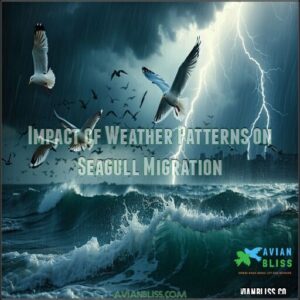This site is supported by our readers. We may earn a commission, at no cost to you, if you purchase through links.
 Yes, seagulls do migrate, but not all follow the same pattern.
Yes, seagulls do migrate, but not all follow the same pattern.
Most seagulls move south during winter when food becomes scarce in northern regions. You’ll notice species like Herring Gulls traveling hundreds of miles along coastlines, while others like Ring-billed Gulls head inland to lakes and landfills.
Some coastal gulls actually stay put year-round when food remains available. Their migration decisions depend on species, age, and local conditions.
Those french fries you’re sharing at the beach might be feeding a bird that’s traveled farther than your last vacation! Understanding their movements reveals fascinating adaptations to our changing environment.
Table Of Contents
- Key Takeaways
- What Triggers Seagull Migration?
- Where Do Seagulls Migrate During Winter?
- Seagull Migration Routes
- Do Seagulls Migrate to Lakes and Inland Areas?
- Impact of Weather Patterns on Seagull Migration
- Seagull Overwintering Behavior
- How Far Do Seagulls Migrate?
- Changes in Seagull Migration Patterns Over Time
- Factors Affecting Seagull Migration
- Frequently Asked Questions (FAQs)
- Where do Seagulls migrate?
- Which Seagull species are known for long-distance migration?
- Where do Seagulls go?
- Why do Seagulls migrate in winter?
- Why should you compare Seagulls with other migratory birds?
- What is the environmental impact of Seagull migration?
- Where do seagulls go during winter?
- Do seagulls hibernate or migrate?
- Do seagulls migrate to lakes?
- Can seagulls survive winter?
- Conclusion
Key Takeaways
- Most seagulls migrate south during winter when food becomes scarce in northern regions, but migration patterns vary significantly by species, with some traveling thousands of miles while others barely move.
- You’ll notice that migration decisions depend on several factors including food availability, temperature changes, and breeding requirements—with some coastal gulls staying put year-round when resources remain accessible.
- Seagulls don’t just migrate along coastlines; they often venture inland to lakes, rivers, and urban areas that offer reliable food sources, freshwater, and protection from harsh coastal weather.
- Climate change is altering traditional seagull migration patterns, causing food scarcity, shifting ranges, and breeding disruptions that force these birds to adapt their migratory behaviors.
What Triggers Seagull Migration?
During autumn, several key factors trigger seagull migration, acting like nature’s alarm clock for these coastal birds.
You’ll notice these triggers are both internal and external.
Hormonal changes begin the process, with birds’ bodies preparing for long journeys as daylight hours decrease.
When temperature drops signal winter’s approach, seagulls respond instinctively to avoid harsh conditions.
Food scarcity becomes particularly important—as fish move to deeper waters and insects disappear, gulls must follow available food sources.
This instinctual behavior has evolved over thousands of years, ensuring survival through challenging seasons.
Climate conditions play a vital role too; storms and freezing temperatures push birds southward.
Many species time their movements around their breeding season, departing after young are independent.
Environmental cues like changing wind patterns and barometric pressure provide additional signals, completing the complex interplay of factors that launch seagulls on their remarkable winter journeys.
These factors work together to ensure the seagulls’ instinctual behavior is triggered at the right time, allowing them to migrate to more favorable climate conditions.
Where Do Seagulls Migrate During Winter?
Now that we comprehend what triggers seagull migration, let’s explore where these birds actually go during winter.
During winter months, seagulls follow specific patterns to reach their wintering grounds. North American gulls typically migrate to South America, while European species head to Africa or the Middle East. Siberian and Greater Black-Headed gulls journey to India and South Asia.
North American gulls soar to South America, while European species seek winter refuge in Africa or the Middle East.
These winter habitats offer:
- Warmer coastal regions with abundant food sources
- Urban shelters providing reliable scavenging opportunities
- Inland destinations with unfrozen lakes and rivers
The distance varies substantially by species. Gulls from northerly latitudes travel up to 6,000 miles to reach suitable winter destinations. Ring-billed gulls often migrate to southern coastal areas or inland lakes, while some Herring Gulls simply move inland rather than traveling long distances. They’re practical travelers, seeking locations that offer both warmth and reliable food during the coldest months.
Seagull Migration Routes
Now that you know where seagulls spend their winters, let’s map their remarkable journeys.
Seagull migration routes follow distinct patterns across continents. North American gulls typically travel to South America, while European gulls head to Africa or the Middle East.
Route fidelity keeps many species returning to the same coastal routes year after year. Understanding migration product availability can help enthusiasts track these birds.
- Transoceanic marvels: Lesser black-backed gulls brave 7,500-kilometer journeys from Russia to East Africa
- Ancient pathways: Bird migration routes evolved over thousands of years
- Family traditions: Young gulls learn migratory routes from parents
- Coastal highways: Many species follow shorelines for navigation
- Stopover sanctuaries: Gulls rest at familiar locations along migration routes
Do Seagulls Migrate to Lakes and Inland Areas?
Seagulls frequently venture far from ocean shores, establishing temporary or permanent homes around lakes and inland areas.
Their movements inland aren’t random but driven by strategic benefits.
| Inland Factor | Benefits for Gulls |
|---|---|
| Freshwater Sources | Preferred drinking water over saltwater |
| Food Availability | Access to landfills, farm fields, and urban waste |
| Urban Gull Nesting | Rooftop safety from predators |
| Winter Roosting Spots | Protection from harsh coastal weather |
Ring-billed gulls particularly thrive in inland environments, often spotted in parking lots hundreds of miles from any coast.
Their adaptable inland gull diet and freshwater adaptation make inland migration a successful survival strategy, driven by the need for freshwater adaptation.
Impact of Weather Patterns on Seagull Migration
After exploring inland migration, let’s examine how weather shapes seagulls’ journeys.
Weather conditions dramatically influence when and how seagulls migrate. Strong winds can either help or hinder their flight paths, while storms may force them to delay travel entirely.
Strong winds guide or challenge seagulls, while storms demand patience, shaping their incredible migratory journeys in tune with nature’s rhythms.
Temperature changes serve as primary migration triggers—when cooler weather arrives, many species head south.
You’ll notice seagull migration patterns shift with climate variability, as these adaptable birds respond to both immediate weather events and seasonal changes.
Precipitation impact can’t be overlooked either, as heavy rainfall affects food availability and visibility during their travels.
Seagull Overwintering Behavior
From September through January, seagulls shift into their winter routines with remarkable adaptability.
According to recent data, these resilient birds display fascinating overwintering behaviors:
- Roosting Locations shift from nesting colonies to sheltered urban areas
- Diet Changes occur as they rely more on inland food sources
- Social Dynamics intensify with larger winter flocks forming
- Energy Conservation becomes priority through reduced activity
- Urban Adaptation increases as they utilize human structures for warmth
You’ll notice seagulls returning to the UK by February, after their "winter holiday."
During colder months, they balance food availability with temperature demands, often choosing locations that offer both shelter and sustenance.
Supplementing their diet with specialized winter food becomes essential for survival.
How Far Do Seagulls Migrate?
While seagulls settle into their winter routines, you might wonder about their journey lengths. The migration variation among these birds is truly remarkable.
- Franklin’s gulls make extreme migrations from Canada to Argentina, covering distances of up to 6,000 miles
- Lesser black-backed gulls travel up to 7,500 miles annually during their migratory journeys
- Sabine’s gulls journey from Arctic regions to wintering grounds off South America and Africa coasts
- Juvenile journeys tend to be longer, with younger birds typically traveling farther than adults
Bird migration distance varies dramatically by species—some barely move 209 miles while others cross entire continents in their seasonal travels.
Changes in Seagull Migration Patterns Over Time
Over decades, the secret journeys of seagulls have revealed fascinating changes in migration patterns. Research shows 65% of seagulls migrate while 35% stay put.
You’ll notice shifting destinations with recovery latitudes moving northward and sedentariness increasing in nearly a third of species. Route deviations are most evident in hybrid gulls, which behave more like Caspian than Herring Gulls.
Distance changes occur with age—Caspian Gulls travel less as they mature. Timing variations appear in decadal maps, while mortality rates for migratory birds are 2.4-3.5 times higher than their homebody counterparts, showing a significant difference in migration behavior.
Factors Affecting Seagull Migration
You’ll find that seagull migration is primarily influenced by food availability, seasonal temperature changes, and breeding requirements that vary by species.
Their journeys, spanning distances from just 100 miles to over 6,000 miles, are also affected by environmental factors like coastal development and climate shifts that continue to modify traditional migration patterns.
Climate Change Impact
While seagull migration patterns have evolved over centuries, climate change now threatens these time-honored journeys.
As our planet warms, you’ll notice seagulls facing unprecedented challenges that alter their natural behaviors:
- Food Scarcity – Warming oceans push fish deeper, making them inaccessible to surface-feeding gulls and triggering increased cannibalism
- Shifting Ranges – Many species are developing smaller bodies with longer wings to travel farther distances on less food
- Breeding Disruption – Rising temperatures affect nesting timing and success rates
Habitat loss and extreme weather events further complicate these patterns.
Some colonies have abandoned migration altogether where winters have sufficiently warmed, while others must fly farther than ever before.
Phenological mismatches reduce reproductive success.
These adaptations serve as critical environmental indicators of our changing world.
Migration Distance
While climate impacts shift patterns, the migration distance of seagulls varies dramatically between species.
You’ll find Franklin’s Gulls traveling an impressive 7,000 miles to Peru annually, while other species make shorter journeys.
Age differences, genetic factors, and fuel reserves all influence how far these birds fly.
Some young seagulls migrate farther than adults, with stopover locations playing vital roles in their journey’s success, influenced by factors such as genetic factors.
Nesting Factors
Beyond distance considerations, nesting factors play a key role in determining when and where you’ll find seagulls during their annual journeys.
When choosing nesting sites, these birds focus on safety, warmth, and proximity to food sources. You’ll notice site selection varies substantially between species – herring gulls prefer coastal breeding areas and clifftops, while black-headed gulls establish nesting colonies inland on open ground or wetlands.
Nesting materials also influence migration timing, as birds must arrive when suitable building resources are available. Colony size and nesting success rates directly affect migration patterns, with larger, successful colonies often maintaining more consistent annual routes.
Frequently Asked Questions (FAQs)
Where do Seagulls migrate?
Many seagulls migrate from northern breeding grounds to southern wintering areas, traveling up to 6,000 miles.
You’ll find some species flying to South America, Africa, or the Mediterranean, while others simply move inland for warmth. Complete concepts
Which Seagull species are known for long-distance migration?
Ever wondered which seagulls travel the farthest?
Franklin’s gull journeys from Canada to Argentina, while Sabine’s gull flies from the Arctic to South America or Africa—both traveling up to 6,000 miles annually.
Where do Seagulls go?
Seagulls travel to warmer coastal regions, inland lakes, or urban areas during winter.
You’ll find them moving south from breeding grounds, with some species like Franklin’s gull journeying from Canada to Argentina, covering thousands of miles.
Why do Seagulls migrate in winter?
You’d be amazed how seagulls transform into winter nomads.
They’re escaping brutal cold temperatures, hunting for food when supplies dwindle, and seeking cozy inland shelters away from harsh coastal winds.
It’s all about survival.
Why should you compare Seagulls with other migratory birds?
Comparing seagulls with other migratory birds helps you understand broader migration patterns, environmental indicators, and adaptive behaviors.
You’ll gain insights into how different species respond to seasonal changes and ecological pressures while enhancing your birdwatching experience.
Comparing seagulls with other migratory birds provides a unique perspective on these topics.
What is the environmental impact of Seagull migration?
Through their migration, you’ll notice seagulls transport nutrients between habitats via droppings, disperse seeds and marine organisms, and regulate insect populations.
They’re also valuable indicators of environmental changes and climate shifts.
Where do seagulls go during winter?
During winter, you’ll find seagulls moving inland to lakes, rivers, and urban areas where it’s warmer.
Many migrate south to warmer climates, while others just travel short distances from their coastal homes.
Do seagulls hibernate or migrate?
Seagulls don’t hibernate but instead migrate seasonally.
You’ll notice most species fly south during winter, traveling hundreds to thousands of miles seeking warmer climates and better food sources rather than entering a dormant state.
Do seagulls migrate to lakes?
Yes, many feathered friends do journey to lakes during migration or seasonal movements.
You’ll notice these birds travel inland when coastal conditions become challenging, seeking freshwater bodies that offer food and shelter during winter months.
Can seagulls survive winter?
Most species are well-equipped to handle cold weather with their waterproof feathers and thick down.
They’ve adapted various survival strategies, including migration to warmer areas when food becomes scarce.
Conclusion
Like birds riding invisible highways across the sky, seagulls’ migratory patterns tell a story of remarkable adaptation.
As you’ve discovered, many seagulls do migrate when winter approaches, though their journeys vary widely by species and available resources.
You’ll find these resourceful birds following ancient routes or adapting to new urban environments, demonstrating nature’s resilience.
Next time you spot a gull, remember—it might be a seasoned traveler on a journey that spans continents, responding to nature’s timeless call.
- https://www.bto.org/sites/default/files/u49/BTO_298pg08-09_LBBG.pdf
- https://www.icarus.mpg.de/30188/seagulls-navigation
- https://en.wikipedia.org/wiki/Gull
- https://birdsandtrees.net/understanding-the-migration-patterns-where-do-seagulls-go-in-the-winter/
- https://worldwidebirder.com/do-seagulls-migrate-where-do-they-go/










